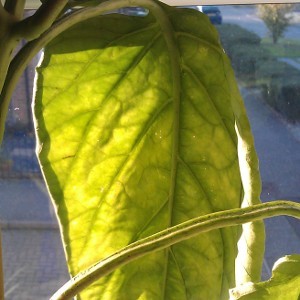Why Are My Garden Plants Turning Yellow?
Unless a plant is meant to be yellow in color (i.e. Gold Dust Plant, Variegated Yucca), yellow leaves are a signal to gardeners that something has gone wrong. Yellowing of the leaves (Chlorosis) can point to a wide variety of health problems, but luckily there are a few tricks to get to the root of the issue. The pattern of yellowing, for example, can be a great clue. The infographic by Safer Brand below will show you what to look for and better yet, what to do about it.
Chlorosis is the visible result of a plant lacking chlorophyll. Chlorophyll is used in photosynthesis and gives the plants their green coloring. As such, when the plant lacks chlorophyll the leaves turn pale or yellow. Because chlorophyll is essential to the plant’s food making ability, lacking this important pigment for an extended period of time can have grave effects.
To remedy chlorosis, there are a few variables in how the chlorosis develops that offer important clues as to the source of the issues.
Garden Plants Need Nutrients
The first thing to consider with chlorotic plants is, “Is the plant getting enough nutrients?” Most gardeners know that plants require hydrogen, carbon and oxygen; but, did you know the plants also require more than twelve other nutrients to simply survive? A soil test is the most comprehensive way to determine which nutrients are missing, but certain deficiencies will also show up in distinct yellowing patterns. For instance, a nitrogen deficiency is recognizable by green veins with yellowing between them.
Some nutrient deficiencies are notable by older leaves turning yellow before younger leaves. This has to do with how mobile the nutrients may be within a plant. For instance, phosphorus and potassium are considered mobile whereas sulfur and copper are not.
Garden Plants Get Pests
While nutrient issues are recognizable by pattern, pest symptoms are a bit trickier. Issues resulting from pests may show up throughout the entire plant, or just in one section. This can make it difficult to determine a “pattern”. If you do discover that the chlorotic issue is pest related, it is important to determine exactly which pest is causing the damage in order to properly remedy the problem. For example, an insecticide or insecticidal soap may work for Lacebugs on Azaleas but will certainly not work on fungal leafspot.
Garden Plants Need Water and Light
As we all know, water and light are essential for life. But, too much of a good thing, at least in the case of water, can also be a bad thing.
Both underwatering and overwatering can lead to yellowing leaves. Under-watered plants are usually brittle with dry surrounding soil. Over-watered plants tend to be limp and mushy, and the soil spongy.
Furthermore, all the nutrients and good intentions in the world are of no use if a plant does not get the light it requires. Inadequate light causes plants to fade and look droopy. All plants are different, and it is key to know how much light your particular plant needs.
Use the infographic from Safer Brands below to diagnose why your plants are turning yellow. Happy gardening!
![]()
Allentuck Landscaping Co. is Your Residential Landscape Company
Phone: 301-515-1900 Email: info@allentucklandscaping.com
At Allentuck Landscaping Company, our mission is to create beautiful environments for people to enjoy. We see landscaping as a way to improve people’s lives.
The Allentuck Landscaping Company team has been delighting homeowners in Maryland, Washington DC and Northern Virginia for over 28 years with our turnkey approach to landscape design, installation, construction and maintenance. Most companies try to serve many types of customers at the same time; homeowners, shopping centers, office buildings and the list goes on. At Allentuck Landscaping Co., we focus on one customer, you, the homeowner. We have a singular focus on bringing you the best landscape practices, the best customer service, and the best value for your home.
Services Provide – Master Landscape Plans, Complete Maintenance Programs, Plantings, Patios, Walkways, Retaining Walls, Water Features, Outdoor Lighting, Outdoor Kitchens, Trellises & Pergolas, Irrigation Systems, Drainage Solutions, Grading & Sodding. Fire Pits & Fire Places, Spring Clean Ups, Decks, Fences, Mosquito & Tick Control, Deer Control.
Areas Served – Chevy Chase, Bethesda, Potomac, Rockville, North Potomac, Darnestown, Gaithersburg, Germantown, Damascus, Boyds, Clarksburg, Ijamsville, Urbana, Frederick in Maryland and Washington DC.

